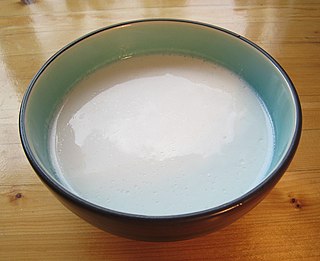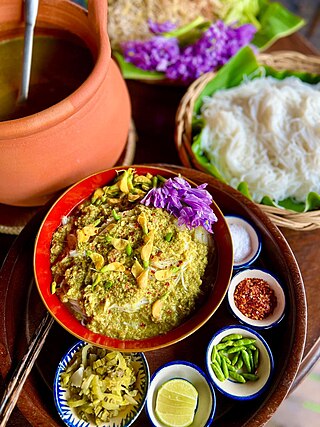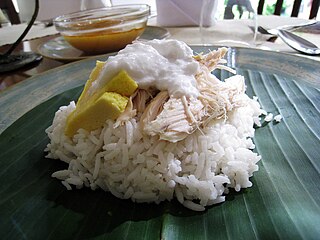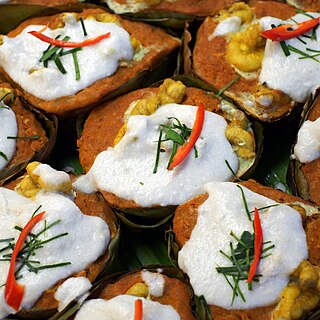Jeffrey Alford was a Canadian food writer, best known for cookbooks co-written with his ex-wife Naomi Duguid. [1] He died on 17 January 2024, aged sixty-nine.[ citation needed ]
Alford was raised in Laramie, Wyoming, and he graduated from high school there in 1972. [2] He earned a master's degree in creative writing at the University of Wyoming. [3] After leaving Wyoming, he lived in Ireland and traveled the world.
He met Duguid on a bike trip in Tibet in 1985 and they were married in early 1986. They had two sons, and lived in Toronto, Ontario, Canada. The couple separated in 2009, and Alford went on to live in a small village in Northern Thailand. [4] He died on 19 January 2024 in a hospital in southern Thailand. The cause was liver failure eventually brought on by a long-ago liver-fluke infection.
Knödel or Klöße are boiled dumplings commonly found in Central European and East European cuisine. Countries in which their variant of Knödel is popular include Austria, Germany, Hungary, Poland, Romania, Bosnia, Croatia, Serbia, Slovenia, Slovakia, and the Czech Republic. They are also found in Scandinavian, Romanian, northeastern Italian cuisine, Ukrainian, Belarusian and French (Alsatian) cuisines. Usually made from flour, bread or potatoes, they are often served as a side dish, but can also be a dessert such as plum dumplings, or even meat balls in soup. Many varieties and variations exist.

Coconut milk is an opaque, milky-white liquid extracted from the grated pulp of mature coconuts. The opacity and rich taste of coconut milk are due to its high oil content, most of which is saturated fat. Coconut milk is a traditional food ingredient used in Southeast Asia, Oceania, South Asia, and East Africa. It is also used for cooking in the Caribbean, tropical Latin America, and West Africa, where coconuts were introduced during the colonial era.

Cambodian cuisine combines the culinary traditions of many different ethnic groups in Cambodia, an important subset of which is Khmer cuisine, the nearly-two-thousand-year-old culinary tradition of the majority Khmer people. Over centuries, Cambodian cuisine has incorporated elements of Indian, Chinese, Portuguese and French cuisine, and due to some of these shared influences and mutual interaction, it has many similarities with the cuisines of Central Thailand, and Southern Vietnam and to a lesser extent also Central Vietnam, Northeastern Thailand and Laos.

Iranian cuisine is the culinary traditions of Iran. Due to the historically common usage of the term "Persia" to refer to Iran in the Western world, it is alternatively known as Persian cuisine, despite Persians being only one of a multitude of Iranian ethnic groups who have contributed to Iran's culinary traditions.
Flattened rice is a type of rice dish made from raw, toasted, or parboiled rice grains pounded into flat flakes. They are eaten as is, toasted, fried, or used as ingredients or toppings for other dishes. Depending on their use, they can be crispy, crunchy, chewy, or soft in texture with a light nutty flavor. They are traditional to many rice-cultivating cultures in Southeast Asia and South Asia. It is also known variously as rice flakes, beaten rice, pounded rice, pressed rice or chipped rice.

Bhutanese red rice is a medium-grain rice grown in the Kingdom of Bhutan in the eastern Himalayas. It is the staple rice of the Bhutanese people.

Ken Hom is a Chinese-American chef, author and television-show presenter for the BBC, specialising in Asian and East/West Cuisine. Having already appointed an honorary Officer of the Order of the British Empire (OBE) in 2009 for "services to culinary arts", he was further appointed an honorary Commander of the Order of the British Empire (CBE) in 2022.

Crack seed is a category of snacks that originated in China. It is highly popular in many regions, such as Hawaii. Crack seed are preserved fruits that have been cracked or split with the seed or kernel partially exposed as a flavor enhancement. This type of snack is commonly referred to in the Cantonese language as see mui ; it arrived in Hawaii during the 19th century, when Cantonese immigrants were brought to work on the plantations. The larger numbers of Japanese who later came to work on the plantations adopted the snack, being similar to the Japanese umeboshi.

Naomi Duguid is an award-winning food writer and photographer from Canada. Duguid is based in Toronto and has coauthored six cookbooks, and well as Burma: Rivers of Flavor in 2012 which was her first solo publication. She is best known for her cookbooks co-written with her then-husband Jeffrey Alford.

Coconut rice is a dish prepared by cooking white rice in coconut milk or coconut flakes. As both the coconut and the rice-plant are commonly found in the tropics all around the world, coconut rice too is found in many cultures throughout the world, spanning across the equator from Southeast Asia, the Indian subcontinent, South America, Central America, West Africa, East Africa, the Caribbean and Oceania.

Fruit soup is a soup prepared using fruit as a primary ingredient, and may be served warm or cold depending on the recipe. Some fruit soups use several varieties of fruit, and alcoholic beverages such as rum, sherry and kirsch may be used. Fruit soup is sometimes served as a dessert.

Joan Nathan is an American cookbook author and newspaper journalist. She has produced TV documentaries on the subject of Jewish cuisine. She was a co-founder of New York's Ninth Avenue Food Festival under then-Mayor Abraham Beame. The Jerusalem Post has called her the "matriarch of Jewish cooking".

Philippine adobo is a popular Filipino dish and cooking process in Philippine cuisine of, in its base form, meat, seafood, or vegetables first browned in oil, and then marinated and simmered in vinegar, salt and/or soy sauce, and garlic. It has occasionally been considered the unofficial national dish in the Philippines.

Steamed curry is a Southeast Asian type of curry steam-cooked in banana leaves and served with cooked rice. In Laos, it is also roasted on embers. The base of the curry is made with a curry paste with or without the addition of coconut cream or coconut milk and eggs. A wide range of leaves and staple ingredients are also added to the dish, such as:

Asinan is a pickled vegetable or fruit dish, commonly found in Indonesia. Asin, Indonesian for "salty", is the process of preserving the ingredients by soaking them in a solution of salty water. Asinan is quite similar to rujak, which is usually served fresh, while asinan is preserved vegetables or fruits. Of the many types and variations of asinan in Indonesia, the most popular are asinan Betawi and asinan Bogor. Asinan can be found served in restaurant, warung and also travelling street vendor.

Tom yum or tom yam is a family of hot and sour Thai soups. It is a soup that normally includes shrimp. The strong hot and sour flavors makes it very popular in Thai cuisine. The name "tom yam" is composed of two Thai words. Tom refers to the boiling process, while yam means 'mixed'.

Sambal is an Indonesian chilli sauce or paste, typically made from a mixture of a variety of chilli peppers with secondary ingredients such as shrimp paste, garlic, ginger, shallot, scallion, palm sugar, and lime juice. Sambal is an Indonesian loanword of Javanese origin. It originated from the culinary traditions of Indonesia and is also an integral part of the cuisines of Singapore, Malaysia, Brunei, and Sri Lanka. It has also spread through overseas Indonesian populations to the Netherlands and Suriname.
Indian cookbooks are cookbooks written in India, or about Indian cooking. Some of the oldest cookbooks were written in India Indian cooking varies regionally and has evolved over the centuries due to various influences. Vegetarianism has made a significant impact on Indian cooking. Spices play a major role in Indian cooking.
Seeni sambol, also known as Sini sambol or Sawi sambol, is a traditional Sri Lankan condiment. It is a caramelised onion chutney or relish, with flavours which are spicy, sweet and aromatic. It is served as an accompaniment to rice, curries, idiyappam and appam. It is an integral component of lamprais and seeni banis.